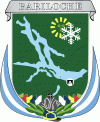San Carlos de Bariloche (San Carlos de Bariloche)
 |
The name Bariloche comes from the Mapudungun word Vuriloche meaning "people from behind the mountain" (vuri = behind, che = people). The Poya people used the Vuriloche pass to cross the Andes, keeping it secret from the Spanish priests for a long time.
There is evidence of the existence of indigenous settlements on banks of Lake Nahuel Huapi, in the area now occupied by the city of Bariloche, prior to arrival of expeditionaries and white settlers. During the Neolithic, the arrival of human beings to Nahuel Huapi region occurs. The archaeological and historical record speaks of tehuelches and puelches presence in the area. With the process of araucanization and mainly since the 17th century, the culture of these groups is strongly affected by Mapuches, who increased their presence from the settlement of Spaniards in Chile, and their continued push east.
At 19th century end, in the vicinity of Nahuel Huapi, only a few scattered indigenous families were there: People of Inacayal had been stripped of their lands, and transferred to Tecka (Chubut) when the cacique was taken prisoner. Curruhinca had made an act of submission to Argentine government with his own. Some Nguillatun was still being celebrated.
But the region was beginning a new stage in its history. Although incorporated into national sovereignty, the Nahuel Huapi area began to develop fundamentally linked to Chile. Before 19th century end, when the border was still in dispute, people from the south of the neighboring country were gradually arriving to settle in surroundings of the lake. Small farmers were most of them from the island of Chiloe, but German immigrants living in Chile also arrived.
Map - San Carlos de Bariloche (San Carlos de Bariloche)
Map
Country - Argentina
 |
 |
| Flag of Argentina | |
The earliest recorded human presence in modern-day Argentina dates back to the Paleolithic period. The Inca Empire expanded to the northwest of the country in Pre-Columbian times. The country has its roots in Spanish colonization of the region during the 16th century. Argentina rose as the successor state of the Viceroyalty of the Río de la Plata, a Spanish overseas viceroyalty founded in 1776. The declaration and fight for independence (1810–1818) was followed by an extended civil war that lasted until 1861, culminating in the country's reorganization as a federation. The country thereafter enjoyed relative peace and stability, with several waves of European immigration, mainly Italians and Spaniards, radically reshaping its cultural and demographic outlook; over 60% of the population has full or partial Italian ancestry, and Argentine culture has significant connections to Italian culture.
Currency / Language
| ISO | Currency | Symbol | Significant figures |
|---|---|---|---|
| ARS | Argentine peso | $ | 2 |
| ISO | Language |
|---|---|
| EN | English language |
| FR | French language |
| DE | German language |
| GN | Guarani language |
| IT | Italian language |
| ES | Spanish language |















